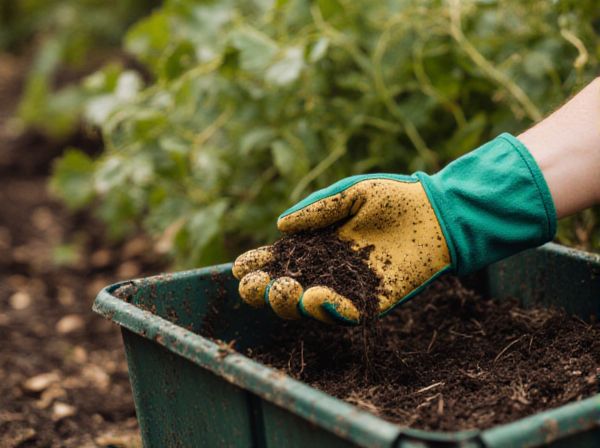
Home Composting vs Community Composting Illustration
Home composting offers the convenience of managing organic waste directly in your backyard, promoting sustainability on a personal scale with easy access and immediate use of compost. Community composting involves shared facilities where larger volumes of food scraps and yard waste are processed, enabling residents without space for home bins to contribute to waste reduction. Both methods reduce landfill use and greenhouse gas emissions, but community composting often supports greater efficiency and educational outreach.
Table of Comparison
| Feature | Home Composting | Community Composting |
|---|---|---|
| Location | Backyard or balcony | Shared community site |
| Scale | Small-scale, individual | Large-scale, multiple users |
| Setup Cost | Low to moderate | Often free or subsidized |
| Maintenance | User-managed | Managed by community or organization |
| Compost Turnaround Time | 2-6 months | 1-3 months |
| Waste Types Accepted | Kitchen scraps, garden waste | Kitchen scraps, yard waste, some types of paper |
| Benefits | Convenient, promotes individual sustainability | Accessible, promotes community engagement, handles larger volumes |
| Challenges | Requires knowledge, space constraints, possible odor issues | Dependency on community participation, site maintenance needed |
Introduction to Home and Community Composting
Home composting involves individuals or households managing organic waste in small-scale bins or piles, enabling nutrient recycling directly in their gardens. Community composting engages neighborhoods or organizations pooling resources and organic materials to create larger composting systems, promoting sustainable waste management at a local level. Both practices reduce landfill waste and foster environmental stewardship by transforming food scraps and yard waste into valuable soil amendments.
Key Differences Between Home and Community Composting
Home composting primarily involves individual households managing organic waste on a small scale using bins or piles, allowing for immediate recycling of kitchen scraps and garden waste. Community composting operates on a larger scale, collecting and processing organic materials from multiple sources in shared facilities, enabling higher volume and more efficient decomposition through specialized equipment. Key differences include the scale of operation, resource input, and potential impacts on waste reduction and soil enrichment.
Benefits of Home Composting
Home composting reduces household waste by recycling organic materials directly on-site, minimizing landfill contributions and greenhouse gas emissions. It enriches garden soil with nutrient-rich compost, improving plant health and reducing the need for chemical fertilizers. This method offers convenience and cost savings, empowering individuals to manage waste sustainably.
Advantages of Community Composting
Community composting offers significant environmental benefits by processing larger volumes of organic waste, reducing landfill contributions more effectively than home composting. It encourages social engagement and shared responsibility among community members, fostering education and sustainable waste management practices on a broader scale. Access to specialized composting equipment in community programs also enables the decomposition of diverse organic materials that are often challenging to manage at home.
Environmental Impact Comparison
Home composting reduces household waste and lowers carbon emissions by minimizing transportation and processing energy compared to community composting. Community composting manages larger volumes of organic waste, reducing landfill methane emissions on a bigger scale, but may involve increased fuel consumption for collection and distribution. Evaluating environmental impact depends on factors such as scale, transportation distance, and waste diversion efficiency.
Cost and Resource Considerations
Home composting typically requires minimal financial investment, relying mainly on basic tools like bins or tumblers and attention to proper organic waste management. Community composting often involves higher initial costs due to shared infrastructure, such as larger-scale composting facilities and coordination expenses, but benefits from collective resource pooling and waste diversion efficiency. Evaluating cost-effectiveness depends on factors like scale, available resources, and community engagement in reducing landfill contributions.
Ease of Use and Accessibility
Home composting offers unparalleled ease of use by allowing individuals to manage organic waste directly at their property with minimal setup, using simple bins or tumblers ideal for small quantities of kitchen scraps and yard waste. Community composting provides higher accessibility by accommodating larger volumes and diverse types of organic material, often supported by local governments or organizations that facilitate collection and processing, making it suitable for urban residents without private outdoor space. Both methods reduce organic waste sent to landfills, but home composting emphasizes convenience and immediate control, while community composting fosters broader participation and resource sharing.
Types of Materials Accepted
Home composting typically accepts fruit and vegetable scraps, coffee grounds, eggshells, grass clippings, and small yard waste, while excluding meat, dairy, and oily foods to prevent pests. Community composting programs often accept a broader range of materials including meat, dairy, and large amounts of yard waste due to industrial processing capabilities. The difference in accepted materials reflects variations in composting technology, scale, and management practices between home and community systems.
Social and Educational Opportunities
Home composting fosters personal responsibility and hands-on learning about waste reduction and soil health, creating an intimate connection with environmental sustainability. Community composting initiatives enhance social cohesion by bringing neighbors together to share resources and knowledge, promoting collective action toward greener practices. These programs often provide educational workshops and outreach, expanding public awareness about composting benefits and eco-friendly habits on a larger scale.
Choosing the Right Composting Method
Home composting suits individuals with limited waste and space, offering direct control over the process and nutrient recycling for personal gardening. Community composting handles larger volumes, efficiently processing diverse organic waste while fostering local collaboration and environmental awareness. Selecting the right composting method depends on factors like available space, waste quantity, desired involvement level, and access to community programs.
Home Composting vs Community Composting Infographic

 gardendif.com
gardendif.com